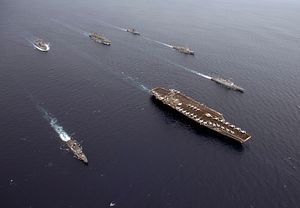After making a pitch for an observer status during this year’s Malabar trilateral naval exercises scheduled to be held in July, Australia has indicated that it is keen for a logistics support agreement with India along the lines of the one concluded with the United States last year. This comes at a time when there is a lot of hue and cry in India about Australia scrapping its skilled visa program — the employer-sponsored temporary work visas, popularly known as the 457 visa. While the government of Malcolm Turnbull may have taken a short-sighted approach in its engagement with India by moving ahead with its new visa restrictions, New Delhi would be equally short-sighted if it just focuses on this issue at the risk of overlooking larger shifts in regional balance of power.
The current transition of power in the Asia-Pacific, underlined by America’s relative decline and China’s growing power, has significant implications for most Asian states. Though the uncertainty around the future of international politics, norms, and institutions does impinge upon all members of the international society, the Asian states find themselves at the forefront of this transition. For them the current transition of power is not only an ideological contest over the form and nature of the international political system but is inextricably linked to their own national security imperatives in a number of ways. India, Japan, and Australia are at the center of this strategic flux in the Indo-Pacific.
The level of strategic convergence between Delhi and Tokyo can be gauged from the fact in 2014, India invited the Japanese Navy to participate in the annual Malabar exercises with the U.S. Navy in the Pacific waters, reviving an earlier practice of joint India-U.S.-Japan trilateral exercises. This was a significant move considering the fact that India had earlier capitulated to China’s reservations when the naval forces of India, U.S., Australia, Singapore, and Japan had conducted joint exercises in the Bay of Bengal in September 2007. After China made its displeasure clear, India refused to be a part of these exercises from 2008. With the coming of Modi government, Japan’s participation in Malabar has been institutionalized. Both Japan and the United States have repeatedly expressed their desires to expand the scope of Malabar exercise. The vision document signed by the Modi and Abe in September 2014 called out for the “regularization of bilateral maritime exercises as well as to Japan’s continued participation in India.” During the seventh round of the trilateral strategic dialogue between the three countries held in Honolulu in June 2015, India agreed to Tokyo’s participation in the 2015 series of Malabar exercises.
India and Japan have an institutionalized trilateral strategic dialogue partnership with the United States. Initiated in 2011. Maintaining a balance of power in the Asian-Pacific as well as maritime security in Indo-Pacific waters became an important element of this dialogue. A similar dialogue exists between the United States, Japan, and Australia. Under Modi, such security trilateralism in Asia has received not only new momentum and is being expanded to incorporate other regional powers: in June 2015, India, Australia, and Japan held their first ever high level dialogue in New Delhi. These trilateral initiatives have a serious potential to transform into a ‘quad’ of democracies in the Indo-Pacific region. The roots of this potential partnership were laid in late 2004 when navies from the U.S., India, Japan, and Australia collaborated in tsunami relief operations all across the Indian Ocean. Japan has been the most vocal supporter of such an initiative. In 2007, Abe, in his earlier stint as Prime Minister, lobbied for Asia’s democracies to come together. This was also actively supported by the United States. Such an initiative resulted in a five nation naval exercise in Bay of Bengal in September 2007 code-named Malabar 07-02. However, perceiving a possible ganging-up of Asia’s democracies, China issued demarches to New Delhi and Canberra, causing this initiative to lose steam, since both Australia and New Delhi felt it unwise to provoke China. As China becomes more aggressive in the region, there are signs that India and Australia may be warming up to the idea again.
India and Australia are wary of China’s assault on maritime security and freedom of navigation in the Indo-Pacific region. These common concerns have strengthened the need for greater maritime cooperation between the two nations and the two have started conducting joint naval combat exercises. During Modi’s visit to Australia, a security framework agreement was signed by the two countries, further underscoring the importance of defense cooperation in the Indian Ocean region. India and Australia are leading powers in the Indian Ocean region. The two countries are also at the helm of Indian Ocean Regional Association (IORA), a formal grouping consisting of the Indian Ocean Littoral States. Australia is also a permanent member of Indian Ocean Naval Symposium, which brings together the local navies of Indian Ocean region. The extent of their regional cooperation in Indian Ocean can also be ascertained by their annual trilateral dialogues with countries like Japan and Indonesia.
The need of the hour is to push for greater engagement with such like-minded nations. Australia has been long keen on joining the Malabar exercises along with the U.S. and Japan. India should favorably consider this request as the idea of an Indo-Pacific democratic quad needs resurrection at the earliest.
A version of this article appeared at Scroll.in.

































